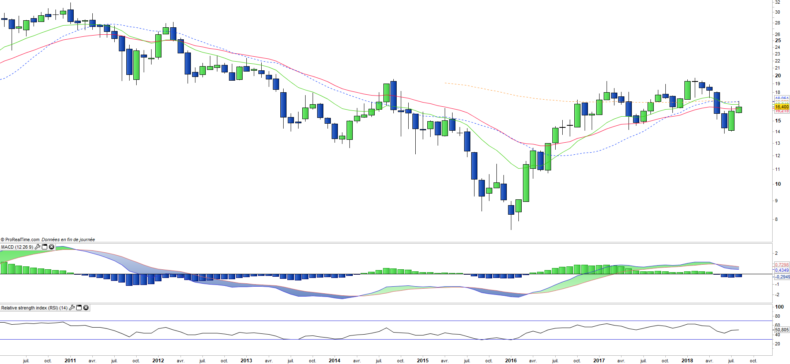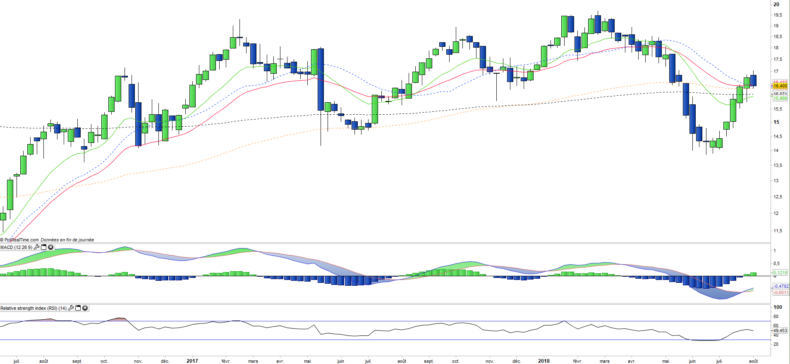Lyxor ETF Brazil Ibovespa - RIO - 09/08/2018
Short Term strategy: Neutral (50%) / Trend +
Long Term strategy: Positive (55%) / Trend =
pour accéder à nos achats / ventes sur les indices
Characteristics of the ETF
The Lyxor RIO ETF (Brazil Index) created in 01/2007,is listed in Euro on Euronext and seeks to replicate the IBOVESPA index which is composed of the 67 main Brazilian stocks, selected according to the size of their market capitalization. This index covers 70% of the Brazilian market capitalization.
The fees of this ETF are 0.65% and the AUM approximately 229M €. Replication is indirect (via Swap) and there is a dividend capitalization policy.
Alternative ETFs: BRZ (Amundi in USD), Ishares (EWZ in USD)
Index & components
The RIO (Lyxor) ETF is a very good proxy for the Brazilian economy.
Financials make up 32% of the index, basic materials account for 20%, and energy accounts for only 13%, after Petrobras fell sharply following corruption scandals.
Brazil is the ninth world economy with a GDP of $ 1800bn (the equivalent of Italy). After a period of very strong growth, the economy has been showing signs of slowing down since 2011 because of the stagnation of commodities prices for export, the slowdown in domestic consumption linked to household indebtedness and lower investments.
In 2015 and 2016, the Brazilian economy plunged into recession (-3.5%) and fiscal difficulties increased but the country emerged from the recession in 2017 and is expected to post moderate growth in 2018, the year of the presidential election. The policy continues to punctuate the markets, after the dismissal of Dilma Rousseff, the imprisonment of former President Lula and the corruption scandals around the current President Tremer. Attempts to adjust the budget and control inflation are on track but need to be deepened. However, with a population of more than 200 million, Brazil also has abundant natural resources and a relatively diversified economy.
Brazil is the world's largest producer of coffee, sugar cane and oranges, one of the world's leading soybean producers, and the country attracts many global agribusiness and biofuel groups. Brazil is also a big industrial country. The exploitation of its mineral wealth has made it the world's second largest exporter of iron and one of the largest producers of aluminum and coal. As a producer of oil, Brazil is considering self-sufficiency in short-term energy production (its reserves could make it one of the top five oil producers). The country is becoming increasingly important in the textile, aeronautics, pharmaceuticals, automotive, steel and chemical industries.
Most major automobile manufacturers have established production units in the country. Brazil has emerged from the recession and has strong medium-term growth potential, yet the country remains highly dependent on oil and commodities.
Latest developments
After a rise of nearly 73% in 2016, the recovery of the Brazilian index continued in 2017 with a performance of + 10.3%, but recorded a decrease of -5% since the beginning of the year 2018 , despite the rise in oil prices. This poor performance is partly related to the fall of the peso against the US dollar, which is linked to the rise in US long-term rates but especially to politics, because in addition to corruption scandals and repeated strikes, the election presidential election promises to be uncertain with no overtly pro-market candidate in a position to win and a reduced alternative between the far right and former President Lula if he is allowed to stand (as currently in jail).
Brazil is going a bit better economically, but 2018 is expected to be a pivotal year, with high-risk presidential elections in October and the economic war that is likely to affect China as one of the country's major markets.
Monthly data
The monthly chart shows a trend that remains positive but that experienced a deep correction. A rebound is in progress, but for the time being still not enough to confirm the end of the correction. For this reason the prices will have to recover over the EMA13 and the EMA100. The index is at a pivotal level because a pull-back on these levels would probably lead to a downward reversal of the long-term trend
Weekly data
On the weekly chart, we can observe the strong bullish reaction that allowed the prices to return to the EMAs 100 and 26 level. The prices must remain above these levels and avoid any relapse to then confirm the return to the underlying trend, which remains bullish despite its chaotic character. The positive crossover of the MACD, which could be confirmed soon by a signal on the other oscillators, is a positive technical factor.
ETF Objective
RIO is a UCITS ETF, listed in EUR, which seeks to replicate the Ibovespa Brasil Sao Paulo Stock Exchange Index
Characteristics
| Inception date | 24/01/2007 |
| Expense ratio | 0,65% |
| Benchmark | Indice Ibovespa |
| Ticker | RIO |
| ISIN | FR0010408799 |
| Currency | € |
| UCITS | Yes |
| EU-SD Status | Out of scope |
| Exchange | Euronext Paris |
| Assets Under Management | 229 M€ |
| Replication Method | Idirect (swap) |
| Dividend | Capitalization |
| PEA | No |
| SRD | Yes |
| Currency Risk | Yes |
| Number of Holdings | 67 |
| Risk | 4/5 |
Country Breakdown
| Brazil | 100% |
Sector Breakdown
| Financials | 32% |
| Materials | 20% |
| Energy | 13% |
| Consumer staples | 11% |
| Consumer discretionary | 7% |
| Industrials | 6% |
| Utilities | 4% |
| Others | 6% |
Top Ten Holdings
| Vale | 13% |
| Itau Unibanco | 11% |
| Banco Bradesco | 8% |
| Petrobras - Petroleo Bras | 6% |
| Ambev | 6% |
| Petrobras - Petroleo Bras | 4% |
| BM&FBOVESPA | 4% |
| Itausa investimentos | 4% |
| Banco do Brasil | 3% |
| Ultrapar Participacoes | 2% |


